Proposed Strategies for Improving Poor Hygrothermal Conditions in Museum Exhibition Rooms and Their Impact on Energy Demand
Abstract
:1. Introduction
2. Research Aim
3. Methods
3.1. Museum Selected for Research
3.2. Model Description and Assumptions for Simulation
3.3. Model Validation
3.4. Model Cases
- Base: actual thermal conditions, heating system works from October 1 to May 15t(temperature set point is 20 °C), no cooling;
- Case 1: the temperature is controlled to 21 ± 2 °C by a heating or cooling system throughout the whole year; the relative humidity is controlled by changing the temperature. If indoor RH differs from 50%, indoor T is reduced or increased by up to 2 °C (at a rate of 0.17 °C/h).
- Case 2: Like case 1, but the temperature can change by ±5 °C (at a rate of 0.17 °C/h).
- Case 3: The temperature is controlled to 21 ± 2 °C by a heating or cooling system throughout the whole year and the relative humidity is controlled by changing the temperature or by changing the ventilation airflow. A hybrid natural/mechanical ventilation system is introduced. If necessary, the outdoor air fans are activated to supply additional airflow into the room. The control system algorithm is presented in Figure 5. The maximum supply airflow is 1100 m3/h (Air change rate is 0.5 h−1), to avoid local discomfort in winter. The Moliere curve was used to calculate the humidity ratio in the control algorithm.
- Case 4: Like case 3 but the relative humidity is set to 40% in winter and 60% in the summer. From May 1 to 31, the set point for RH is gradually increased from 40% to 60%, in November the reverse is applied. These periods were selected after analyzing the annual variation in the relative humidity in the base building.
4. Results
5. Conclusions
Author Contributions
Funding
Acknowledgments
Conflicts of Interest
References
- Sciurpi, F.; Carletti, C.; Cellai, G.; Pierangioli, L. Environmental monitoring and microclimatic control strategies in “La Specola” museum of Florence. Energy Build. 2015, 95, 190–201. [Google Scholar] [CrossRef]
- Haiad, J.C.; Druzik, J.; Ayres, J.M.; Lau, H. Museum environmental requirements: A literature survey. ASHRAE Trans. 1990, 96, 112–121. [Google Scholar]
- Thomson, G. The Museum Environment, 2nd ed.; Butterworth-Heinemann: London, UK, 1986. [Google Scholar]
- Webb, A.L. Energy retrofits in historic and traditional buildings: A review of problems and methods. Renew. Sustain. Energy Rev. 2017, 77, 748–759. [Google Scholar] [CrossRef]
- Schito, E.; Testi, D. Integrated maps of risk assessment and minimization of multiple risks for artworks in museum environments based on microclimate control. Build. Environ. 2017, 123, 585–600. [Google Scholar] [CrossRef]
- Lucchi, E. Multidisciplinary risk-based analysis for supporting the decision making process on conservation, energy efficiency, and human comfort in museum buildings. J. Cult. Herit. 2016, 22, 1079–1089. [Google Scholar] [CrossRef]
- Gebhardt, C.; Konopka, D.; Börner, A.; Mäder, M.; Kaliske, M. Hygro-mechanical numerical investigations of a wooden panel painting from “Katharinenaltar” by Lucas Cranach the Elder. J. Cult. Herit. 2018, 29, 1–9. [Google Scholar] [CrossRef]
- Silva, H.E.; Henriques, F.M.A. Preventive conservation of historic buildings in temperate climates. The importance of a risk-based analysis on the decision-making process. Energy Build. 2015, 107, 26–36. [Google Scholar] [CrossRef]
- Ascione, F.; de Rossi, F.; Vanoli, G.P. Energy retrofit of historical buildings: Theoretical and experimental investigations for the modelling of reliable performance scenarios. Energy Build. 2011, 43, 1925–1936. [Google Scholar] [CrossRef]
- Bøhm, B.; Ryhl-Svendsen, M. Analysis of the thermal conditions in an unheated museum store in a temperate climate. On the thermal interaction of earth and store. Energy Build. 2011, 43, 3337–3342. [Google Scholar] [CrossRef]
- Camuffo, D.; Pagan, E.; Bernardi, A.; Becherini, F. The impact of heating, lighting and people in re-using historical buildings: A case study. J. Cult. Herit. 2004, 5, 409–416. [Google Scholar] [CrossRef]
- ASHRAE Standard 55–2017 Thermal Environmental Conditions for Human Occupancy; American Society of Heating, Refrigerating and Air Conditioning Engineers: Atlanta, GA, USA, 2017.
- EU Standard EN 15251:2007 Indoor Environmental Input Parameters for Design and Assessment of Energy Performance of Buildings Addressing Indoor Air Quality, Thermal Environment, Lighting and Acoustics; European Committee for Standardization: Brussels, Belgium, 2007.
- Lucchi, E. Simplified assessment method for environmental and energy quality in museum buildings. Energy Build. 2016, 117, 216–229. [Google Scholar] [CrossRef]
- EU Standard CEN TC 346 Standard, Conservation of Cultural Heritage; European Committee for Standardization: Brussels, Belgium, 2009–2014.
- EU Standard CEN CR 1752 Standard, Ventilation for Buildings—Design Criteria for the Indoor Environment; European Committee for Standardization: Brussels, Belgium, 1998.
- EU Standard EN 15757:2010 Conservation of Cultural Property—Specifications for Temperature and Relative Humidity to Limit Climate-induced Mechanical Damage in Organic Hygroscopic Materials; European Committee for Standardization: Brussels, Belgium, 2010.
- American Society of Heating, Refrigerating and Air Conditioning Engineers. ASHRAE Handbook—HVAC Applications. Chapter 23: Museums, Galleries, Archives, and Libraries, SI ed.; American Society of Heating, Refrigerating and Air-Conditioning Engineers: Atlanta, GA, USA, 2015. [Google Scholar]
- Italian Standard UNI 10586:1997 Documentation—Climatic Conditions to Document Storage of Graphic Documents and Characteristics of Lodging; Uni Ente Italiano Di Normazione: Rome, Italy, 1997. (In Italian)
- Italian Standard UNI 10829:1999 Works of Art of Historical Importance—Ambient Conditions or the Conservation—Measurement and Analysis; Uni Ente Italiano Di Normazione: Rome, Italy, 1999. (In Italian)
- Italian Standard UNI 10969:2002 Cultural Heritage—General Principles for the Choice and the Control of the Microclimate to Preserve Cultural Heritage in Indoor Environments; Uni Ente Italiano Di Normazione: Rome, Italy, 2002. (In Italian)
- International Institute of Conservation. IIC 2014. Joint IIC—ICOM CC Declaration on Environmental Guidelines. Available online: http://www.iiconservation.org/node/5168 (accessed on 10 January 2019).
- Lucchi, E. Review of preventive conservation in museum buildings. J. Cult. Herit. 2018, 29, 180–193. [Google Scholar] [CrossRef]
- Lamonaca, F.; Pizzuti, G.; Arcuri, N.; Palermo, A.M.; Morello, R. Monitoring of environmental parameters and pollution by fungal spores in the National Gallery of Cosenza: A case of study. Measurement 2014, 47, 1001–1007. [Google Scholar] [CrossRef]
- López-Aparicio, S.; Smolík, J.; Masková, L.; Soucková, M.; Grøntoft, T.; Ondrácková, L.; Stankiewicz, J. Relationship of indoor and outdoor air pollutants in a naturally ventilated historical building envelope. Build. Environ. 2011, 46, 1460–1468. [Google Scholar]
- Corgnati, S.P.; Fabi, V.; Filippi, M. A methodology for microclimatic quality evaluation in museums. Application to a temporary exhibit. Build. Environ. 2009, 44, 1253–1260. [Google Scholar] [CrossRef]
- Ascione, F.; Minichiello, F. Microclimatic control in the museum environment: Air diffusion performance. Int. J. Refrig. 2010, 33, 806–814. [Google Scholar] [CrossRef]
- Ferdyn-Grygierek, J.; Grygierek, K. HVAC control methods for drastically improved hygrothermal museum microclimates in warm season. Build. Environ. 2019, 149, 90–99. [Google Scholar] [CrossRef]
- Schijndel, A.W.M.; Schellen, H.L.; Wijffelaars, J.L.; van Zundert, K. Application of an integrated indoor climate, HVAC and showcase model for the indoor climate performance of a museum. Energy Build. 2008, 40, 647–653. [Google Scholar] [CrossRef]
- Ascione, F.; Bellia, L.; Capozzoli, A.; Minichiello, F. Energy saving strategies in air-conditioning for museums. Appl. Therm. Eng. 2009, 29, 676–686. [Google Scholar] [CrossRef]
- Sharif-Askari, H.; Abu-Hijleh, B. Review of museums’ indoor environment conditions studies and guidelines and their impact on the museums’ artifacts and energy consumption. Build. Environ. 2018, 143, 186–195. [Google Scholar] [CrossRef]
- Kramer, R.; Schellen, H.; van Schijndel, A. Impact of ASHRAE’s museum climate classes on energy consumption and indoor climate fluctuations: Full-scale measurements in museum Hermitage. Amsterdam. Energy Build. 2016, 130, 286–294. [Google Scholar] [CrossRef]
- Kramer, R.; van Schijndel, J.; Schellen, H. Dynamic setpoint control for museum indoor climate conditioning integrating collection and comfort requirements: Development and energy impact for Europe. Build. Environ. 2017, 118, 14–31. [Google Scholar] [CrossRef]
- Kramer, R.P.; Maas, M.P.E.; Martens, M.H.J.; van Schijndel, A.W.M.; Schellen, H.L. Energy conservation in museums using different setpoint strategies: A case study for a state-of-the-art museum using building simulations. Appl. Energy 2015, 158, 446–458. [Google Scholar] [CrossRef]
- Kupczak, A.; Sadłowska-Sałęga, A.; Krzemień, L.; Sobczyk, A.; Radoń, J.; Kozłowski, R. Impact of paper and wooden collections on humidity stability and energy consumption in museums and libraries. Energy Build. 2018, 158, 77–85. [Google Scholar] [CrossRef]
- Živković, V.; Džikić, V. Return to basics—Environmental management for museum collections and historic houses. Energy Build. 2015, 95, 116–123. [Google Scholar] [CrossRef]
- Muñoz-González, C.; León-Rodríguez, Á.; Suárez Medina, R.; Teeling, C. Hygrothermal performance of worship spaces: Preservation, comfort, and energy consumption. Sustainability 2018, 10, 3838. [Google Scholar] [CrossRef]
- Janssen, H.; Christensen, J.E. Hygrothermal optimisation of museum storage spaces. Energy Build. 2013, 56, 169–178. [Google Scholar] [CrossRef]
- Romano, F.; Colombo, L.P.M.; Gaudenzi, M.; Joppolo, C.M.; Romano, L.P. Passive control of microclimate in museum display cases: A lumped parameter model and experimental tests. J. Cult. Herit. 2015, 16, 413–418. [Google Scholar] [CrossRef]
- Rota, M.; Corgnati, S.P.; Di Corato, L. The museums in historical buildings: Energy and systems. The project of the Fondazione Musei Senesi. Energy Build. 2015, 95, 138–143. [Google Scholar] [CrossRef]
- Kramer, R.; van Schijndel, J.; Schellen, H. Dynamic setpoint calculation including collection and comfort requirements: Energy impact for museums in Southern Europe. Energy Procedia 2017, 133, 195–206. [Google Scholar] [CrossRef]
- Korotcenkov, G. Handbook of Humidity Measurement Methods: Materials and Technologies; Taylor & Francis Group, LLC: Abingdon, UK, 2018; Available online: https://www.routledgehandbooks.com/doi/10.1201/b22369-3 (accessed on 10 January 2019).
- Engineering Reference, EnergyPlus™ Version 8.7 Documentation; U.S. Department of Energy: Washington, DC, USA, 2016. Available online: https://energyplus.net/sites/all/modules/custom/nrel_custom/pdfs/ pdfs_v8.7.0/EngineeringReference.pdf (accessed on 12 February 2018).
- Ferdyn-Grygierek, J. Monitoring of indoor air parameters in large museum exhibition halls with and without air-conditioning systems. Build. Environ. 2016, 107, 113–126. [Google Scholar] [CrossRef]
- Ferdyn-Grygierek, J. Indoor environment quality in the museum building and its effect on heating and cooling demand. Energy Build. 2014, 85, 32–44. [Google Scholar] [CrossRef]
- Walton, W.G.N.; Dols, S. CONTAM 2.4 User Guide and Program Documentation; National Institute of Standards and Technology: Gaithersburg, MD, USA, 2005.
- Ferdyn-Grygierek, J.; Baranowski, A. Internal environment in the museum building—Assessment and improvement of air exchange and its impact on energy demand for heating. Energy Build. 2015, 92, 45–54. [Google Scholar] [CrossRef]
- Typical Meteorological and Statistical Climatic Data for the Energy Calculation of Buildings. Available online: https://www.miir.gov.pl/strony/zadania/budownictwo/charakterystyka-energetyczna-budynkow/dane-do-obliczen-energetycznych-budynkow-1/ (accessed on 10 January 2019).
- Ferdyn-Grygierek, J.; Lubina, P.; Kaczmarczyk, J. Analysis of visitors impact on the museum rooms microclimate. Healthy Buildings Europe 2017, Lublin, Poland, July 2–5. Available online: https://www.isiaq.org/docs/presentation/0136.pdf (accessed on 10 January 2019).
- American Society of Heating, Refrigerating and Air Conditioning Engineers. ASHRAE Handbook, Fundamentals, SI ed.; American Society of Heating, Refrigerating and Air Conditioning Engineers: Atlanta, GA, USA, 1997. [Google Scholar]
- Silva, H.E.; Henriques, F.M.A.; Henriques, T.A.S.; Coelho, G. A sequential process to assess and optimize the indoor climate in museums. Build. Environ. 2016, 104, 21–34. [Google Scholar] [CrossRef]
- Grygierek, K.; Ferdyn-Grygierek, J. Multi-objectives optimization of ventilation controller for passive cooling in residential buildings. Sensors 2018, 18, 1144. [Google Scholar] [CrossRef]
- Genco, A.; Viggiano, A.; Viscido, L.; Sellitto, G.; Magi, V. Numerical simulation of energy systems to control environment microclimate. Int. J. Heat Technol. 2016, 34, S545–S552. [Google Scholar] [CrossRef]
- De Tommasi, L.; Ridouane, H.; Giannakis, G.; Katsigarakis, K.; Lilis, G.N.; Rovas, D. Model-based comparative evaluation of building and district control-oriented energy retrofit scenarios. Buildings 2018, 8, 91. [Google Scholar] [CrossRef]


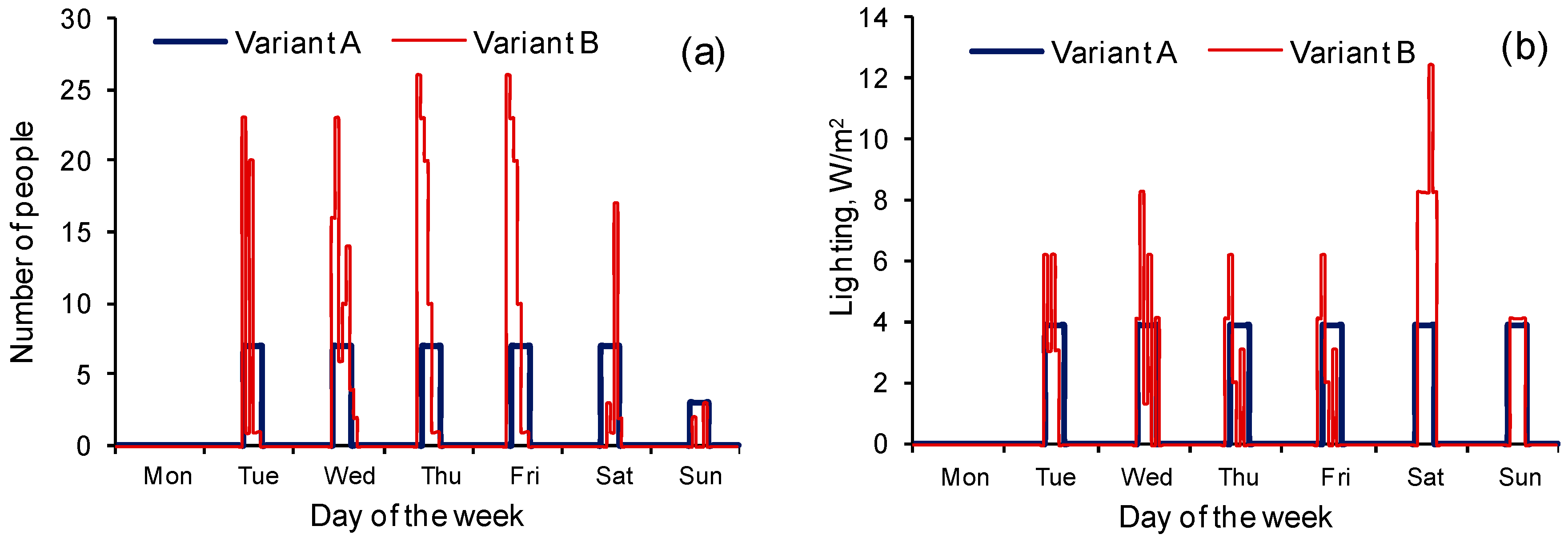
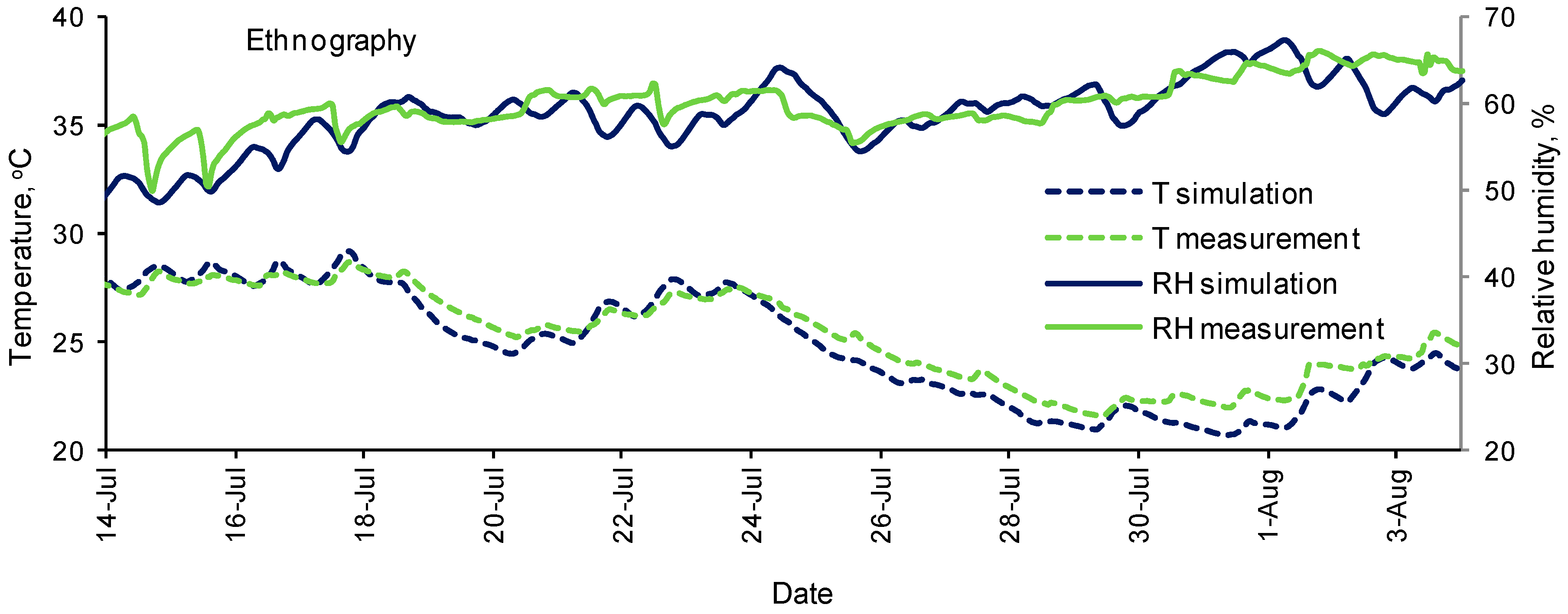
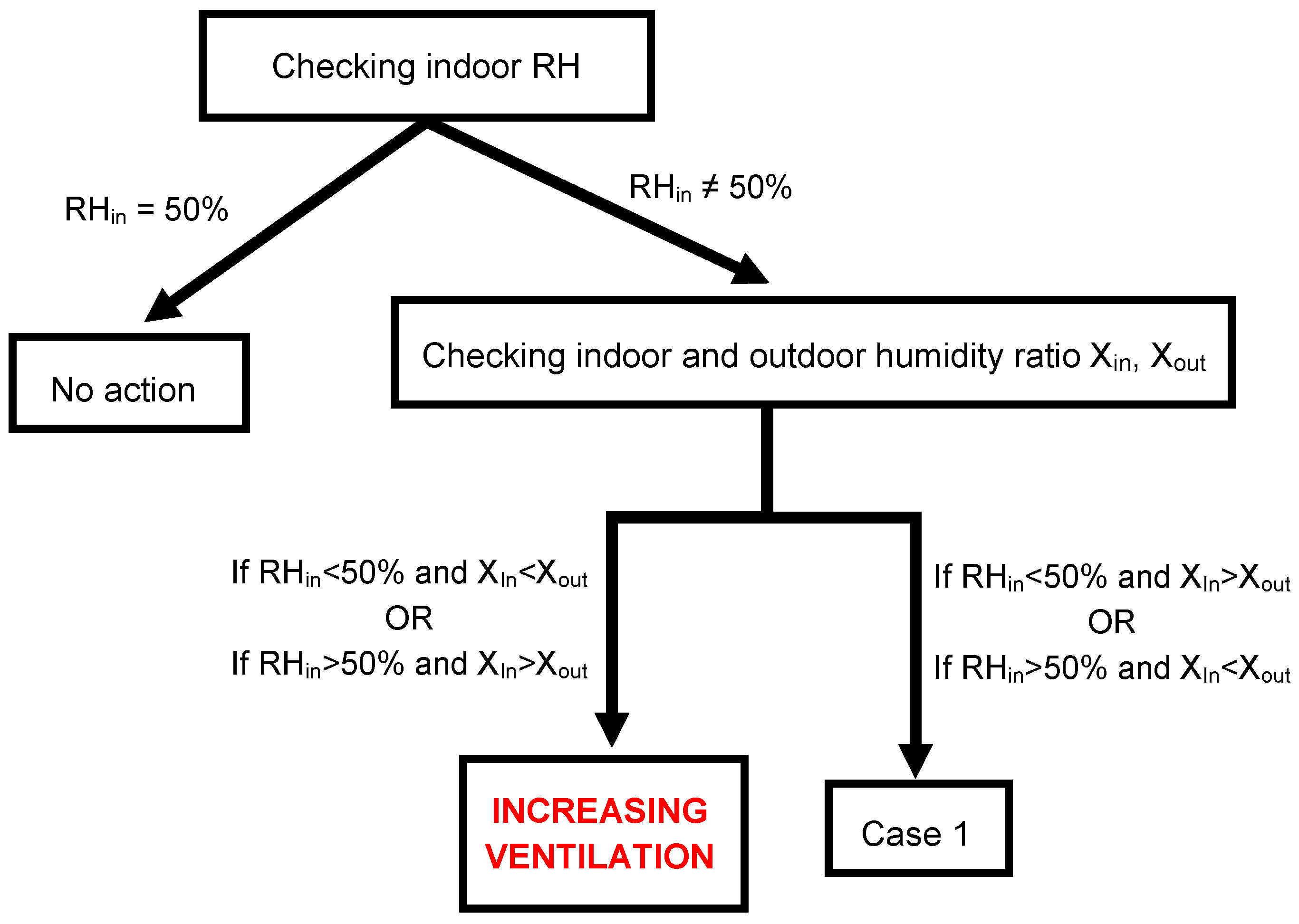
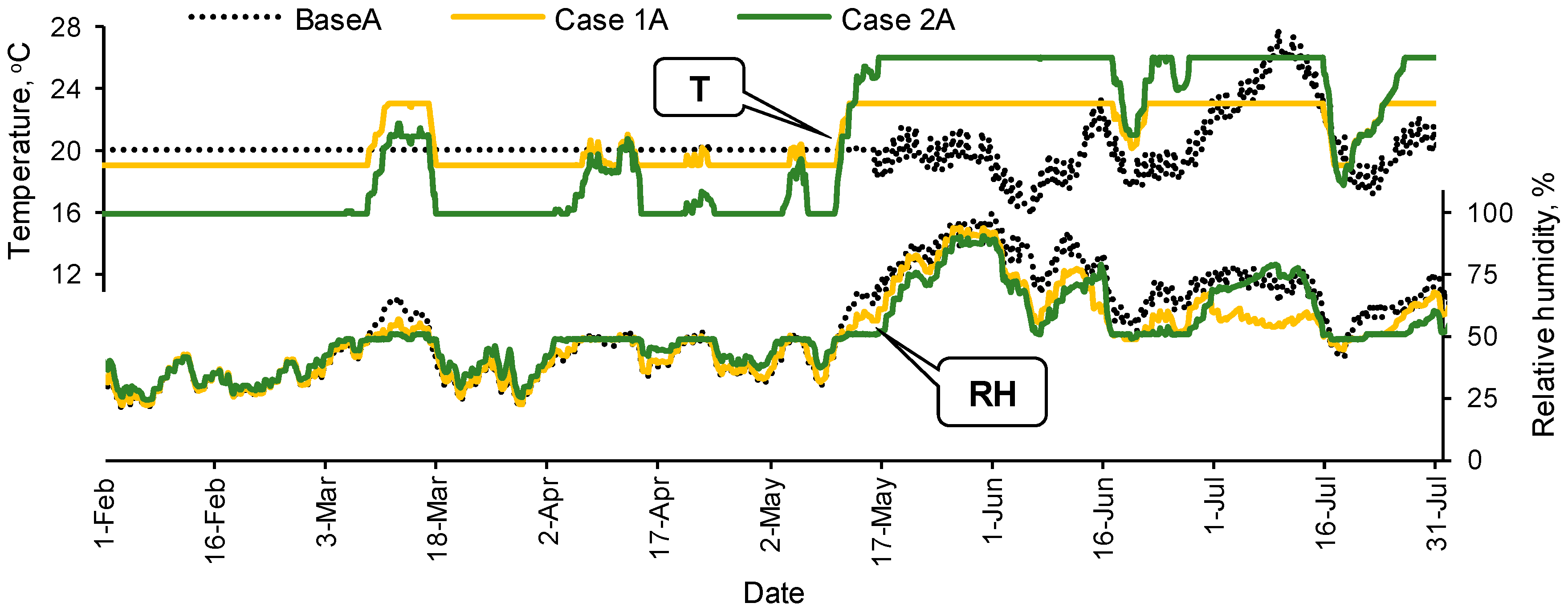

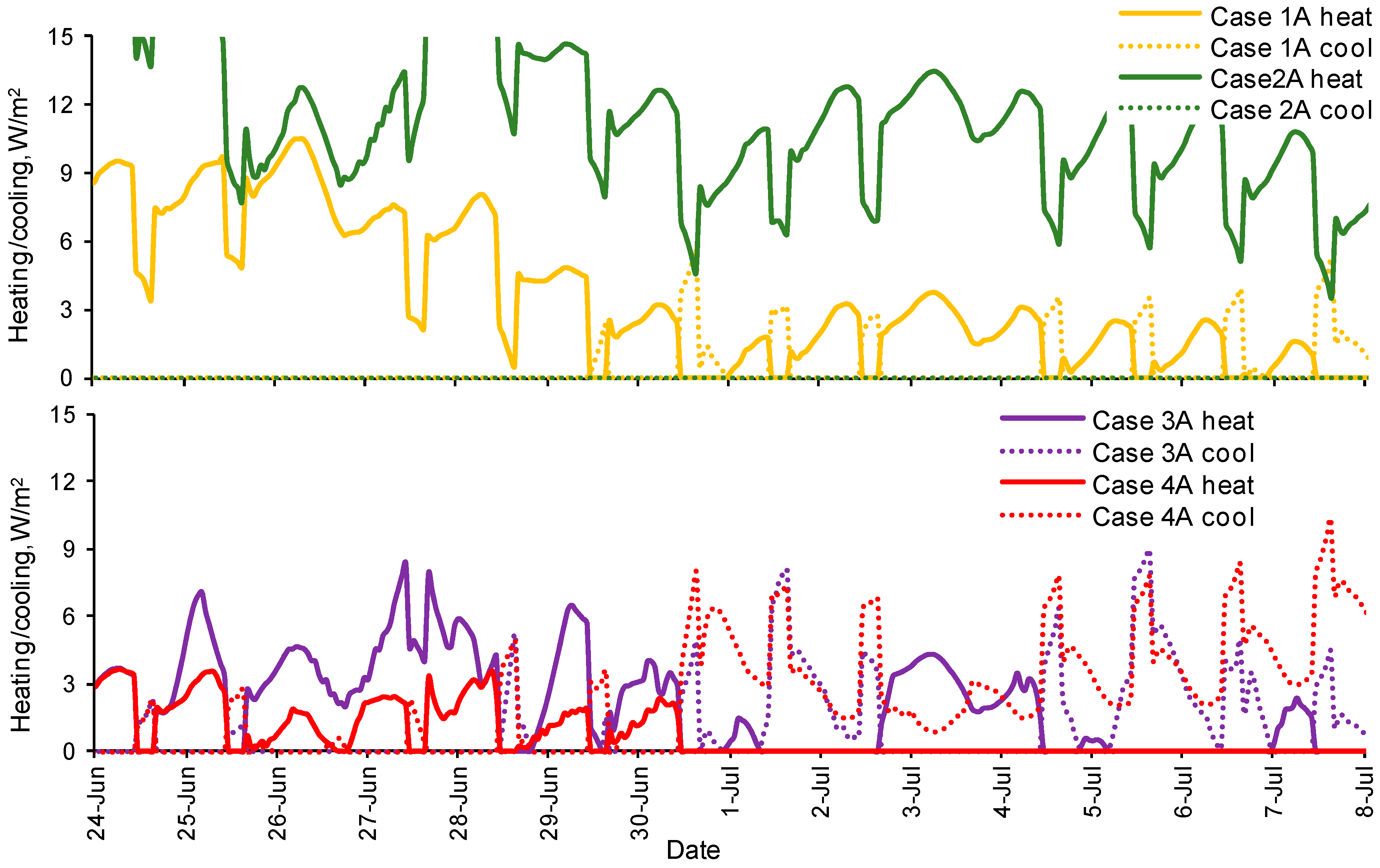
| Set Point | Maximum Fluctuations and Gradients in Controlled Spaces | ||
|---|---|---|---|
| Class | Short-Term Fluctuations | Long-Term (Seasonal) Fluctuations | |
| T = 15–25 °C; RH = 50% (or historic annual average) | AA | ±2 °C; ±5% RH | Up 5 °C, down 5 °C; RH no change |
| A | ±2 °C; ±5% RH | Up 5 °C, down 10 °C; Up 10% RH, down 10% RH | |
| ±2 °C; ±10% RH | Up 5 °C, down 10 °C; RH no change | ||
| B | ±5 °C; ±10% RH | Up 10 °C, but not above 30 °C; Up 10%, down 10% RH | |
| Feature | Value |
|---|---|
| Number of Museum Floors | 3 + 1 (attic) |
| Total Exhibition Area | 2320 m2 |
| Floor-to-Floor Height | 3.6 m |
| External Wall Construction | Concrete or solid brick, uninsulated |
| Windows Construction | Double-glazed, some with anti-reflective coating |
| Ventilation | Natural |
| Heating System | The whole building: central heating system with radiators partly equipped with thermostat valves. The Gallery of Painting and Modern Art halls: fan-coil system switched between cooling mode and heating mode (twice a year). The set point temperature is 20 °C. The heating season: from the turn of September and October to around mid-May. |
| Cooling System | Only present in the Gallery of Painting and Modern Art halls: fan-coils switched twice a year between cooling and heating modes. The set point temperature is 22 °C. |
| Humidification System | Only present in the Gallery of Painting: one autonomous manually controlled air humidifier, the set point RH is 40%. |
| Component | Details |
|---|---|
| Simulation Time Step | 15 min |
| Simulation Period | From January to December |
| Climate Data | Standard climate for Katowice (Southern Poland) [48]: moderate climate with relatively cold winters (min −19 °C) and warm summers (max 31 °C). |
| Occupants | Adopted from measurement tallies of visitors to this museum [49] (on Monday the museum is closed to visitors): Variant A: average from the whole year observation, Figure 3; from July to August (holiday season), the number of people is reduced to 3. Variant B: detailed from one-week observation (Figure 3), the whole year has the same schedule. The total heat for one person (126 W) was assumed according to ASHRAE [50]. The sensible and latent heat gains were calculated in each time step depending on indoor temperature. |
| Lighting | Variant A: average value of 3.87 W/m2 during the whole year, activated during occupied hours. Variant B: the same during the whole year (Figure 3). |
| Case | Performance Index Value, % of Time | ||
|---|---|---|---|
| Whole Year | Cold Period | Warm Period | |
| Base A * | 11.7 | 17.6 | 1.8 |
| Case 1A | 23.5 | 25.2 | 20.7 |
| Case 2A | 36.3 | 36.8 | 35.6 |
| Case 3A | 53.8 | 43.9 | 70.0 |
| Case 4A | 78.4 | 68.0 | 93.9 |
| Base B * | 14.2 | 21.6 | 1.9 |
| Case 1B | 23.6 | 31.3 | 10.8 |
| Case 2B | 28.8 | 39.1 | 11.9 |
| Case 3B | 55.0 | 52.3 | 59.4 |
| Case 4B | 81.3 | 69.9 | 97.3 |
| Case | Performance Index Value, % of Time | ||
|---|---|---|---|
| Whole Year | Cold Period | Warm Period | |
| Base A * | 24.4 | 33.9 | 8.2 |
| Case 1A | 42.0 | 41.2 | 43.3 |
| Case 2A | 51.1 | 52.7 | 48.5 |
| Case 3A | 70.1 | 58.2 | 89.6 |
| Case 4A | 91.1 | 86.7 | 98.3 |
| Base B * | 24.4 | 37.2 | 3.3 |
| Case 1B | 37.4 | 44.1 | 26.3 |
| Case 2B | 41.4 | 52.6 | 23.0 |
| Case 3B | 72.8 | 65.0 | 85.7 |
| Case 4B | 93.7 | 90.4 | 98.7 |
| Case | Heating Demand (kWh/m2) | Relative Difference in Heating to Case 1 | Cooling Demand (kWh/m2) | Relative Difference in Cooling to Case 1 | Total Energy Demand (kWh/m2) | Relative Difference in Total Energy to Case 1 |
|---|---|---|---|---|---|---|
| Base A | 103.0 | - | - | - | 103.0 | - |
| Case 1A | 114.5 | - | 0.7 | - | 115.1 | - |
| Case 2A | 119.5 | 4.4% | 1.8 | 160.9% | 121.3 | 5.4% |
| Case 3A | 97.7 | −14.7% | 1.3 | 90.9% | 99.0 | −14.0% |
| Case 4A | 98.7 | −13.8% | 3.2 | 371.8% | 101.9 | −11.5% |
| Base B | 102.1 | - | - | - | 102.1 | - |
| Case 1B | 121.5 | - | 1.2 | - | 122.1 | - |
| Case 2B | 134.7 | 10.8% | 1.5 | 25.8% | 136.2 | 11.0% |
| Case 3B | 98.3 | −19.1% | 2.1 | 70.4% | 100.4 | −18.2% |
| Case 4B | 100.7 | −17.1% | 3.7 | 210.5% | 104.5 | −14.9% |
© 2019 by the authors. Licensee MDPI, Basel, Switzerland. This article is an open access article distributed under the terms and conditions of the Creative Commons Attribution (CC BY) license (http://creativecommons.org/licenses/by/4.0/).
Share and Cite
Ferdyn-Grygierek, J.; Grygierek, K. Proposed Strategies for Improving Poor Hygrothermal Conditions in Museum Exhibition Rooms and Their Impact on Energy Demand. Energies 2019, 12, 620. https://doi.org/10.3390/en12040620
Ferdyn-Grygierek J, Grygierek K. Proposed Strategies for Improving Poor Hygrothermal Conditions in Museum Exhibition Rooms and Their Impact on Energy Demand. Energies. 2019; 12(4):620. https://doi.org/10.3390/en12040620
Chicago/Turabian StyleFerdyn-Grygierek, Joanna, and Krzysztof Grygierek. 2019. "Proposed Strategies for Improving Poor Hygrothermal Conditions in Museum Exhibition Rooms and Their Impact on Energy Demand" Energies 12, no. 4: 620. https://doi.org/10.3390/en12040620





